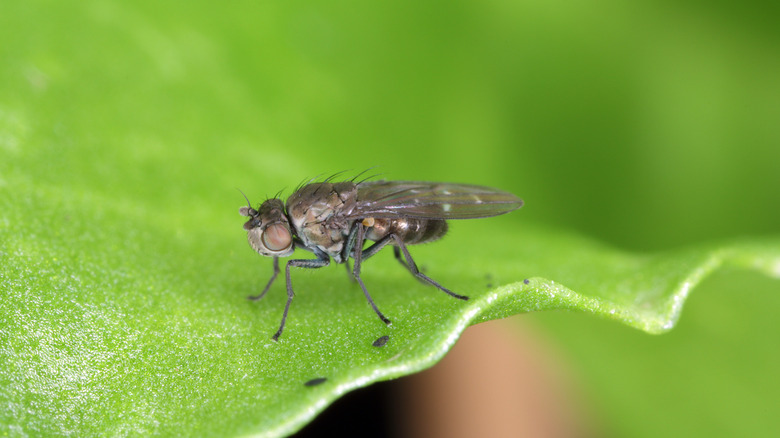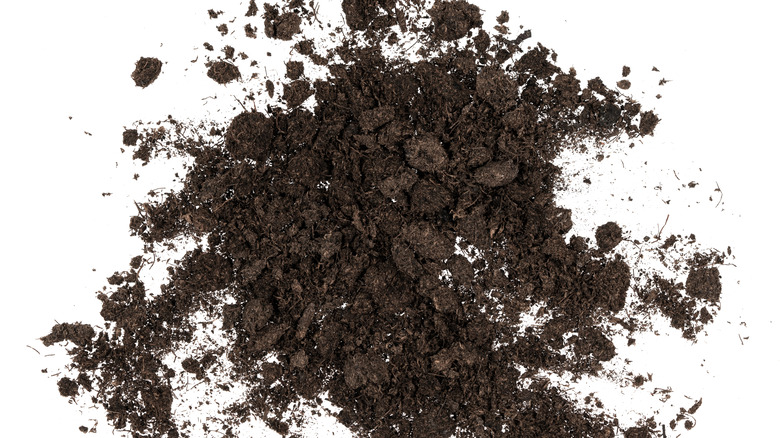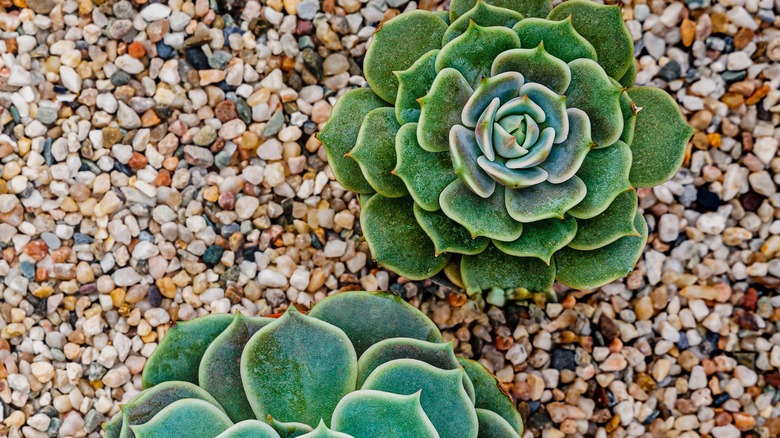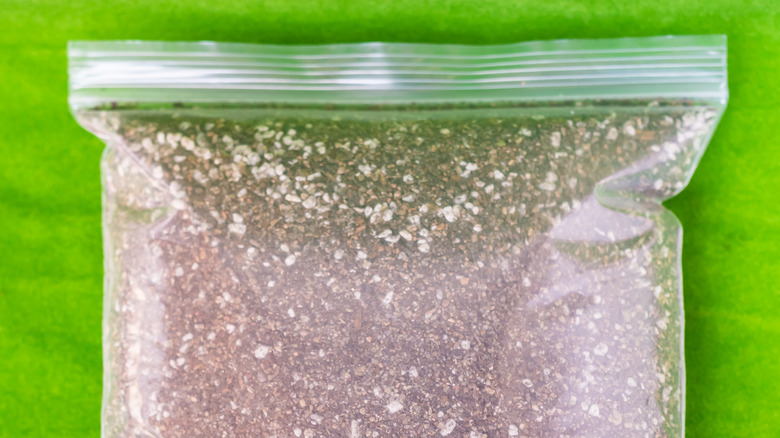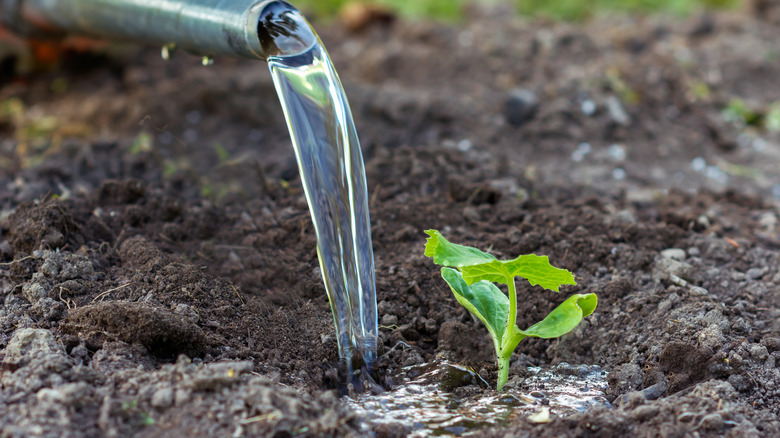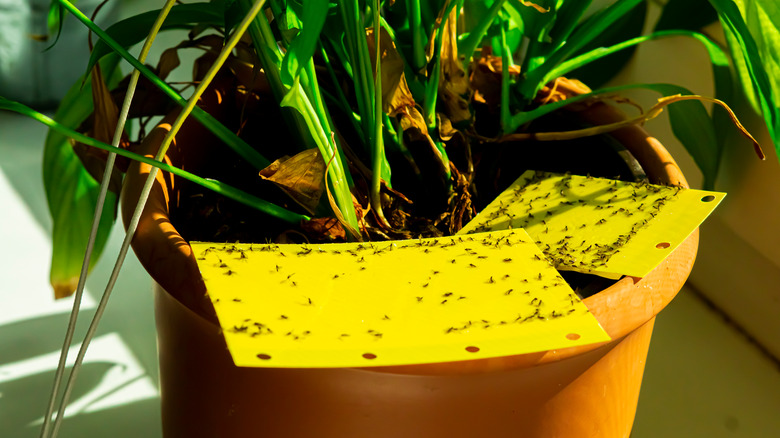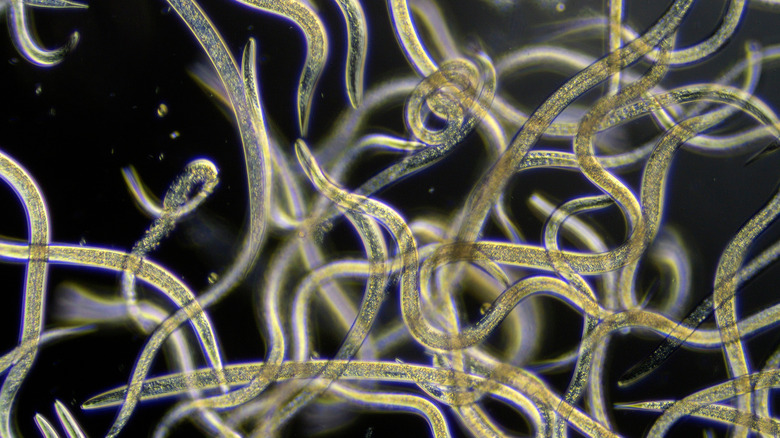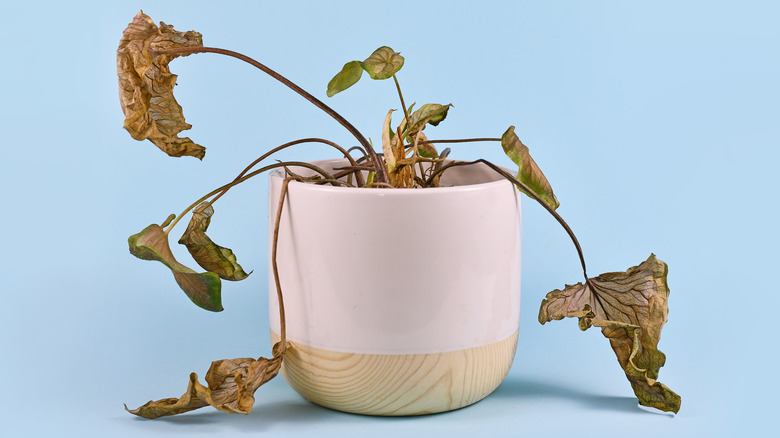How To Keep Gnats Away From Plants
Growing plants on your own can be an easy and incredibly rewarding experience. It can help to liven up your living space while adding a touch of nature to your home. However, there is also the possibility of unwanted pests making themselves comfortable in your plants which could cause a nuisance. Even teeny-tiny bugs like fungus gnats may not seem like a big deal at first, but once they settle in, they have the potential of ruining your precious plants. Fungus gnats are little flying insects that closely resemble a fruit fly. Although they don't pose a threat to humans, these tiny terrors can eventually kill your plant if not properly treated, per Almanac. The lifespan of a gnat may only reach about three weeks, from egg to adult fly. In this time, adult flies lay eggs in the shallow layers of the moist topsoil of plants. Eventually, the larvae hatch and start to feed on the fungus in the soil. Once they reach adulthood, they surface and start the cycle over again.
It may not seem like a big deal at first, but School of Bugs noted that when the number of larvae from these pesky critters increases, it could lead to damaging results. If not eradicated quickly, then the number of organic matter munching larvae could dramatically increase, and soon they will be feeding on the healthy roots of your plants, which could eventually kill them. Here are some great ways to keep gnats away from your plants.
Separate any infected plants
Just like staying clear of your friends and family if you catch a cold could help them not get sick, it could be beneficial to separate your plants in order to stop the spread of gnats. It is especially important to isolate the plant once you've noticed an infestation of gnats occurring, according to ABC Everyday; that way, you can safely treat the infected plant.
Try moving the plants to opposite sides of the house or even in a closed-off area of your home. If you don't have the space, setting up a plastic curtain in the same room or moving the gnat-filled plant outside could be a good idea. It is also a good rule of thumb to isolate newly purchased plants or ones that you are transporting from outdoors to indoors, just in case there is the worry of pests coming along for the ride.
Keep the top of your plant's soil dry
An effective way to deter the spread of gnats if you already have them or to discourage adult gnats from setting up shop in your houseplant is to keep the soil to your plants on the dryer side. Ensuring that the top layer of your plant's soil is dry could deter gnats as they are particularly attracted to really moist plant soil. It's this type of soil that adult gnats find suitable to lay their eggs, per the University of California Agriculture & Natural Resources (UC IPM).
By making this soil as inhospitable as possible to the larvae that hatch into eggs, you could potentially stop an infestation from happening. Obviously, you don't want to starve your plant of vital water. The trick is to keep the uppermost part of the soil dry to the touch. To test this, simply stick your finger into the soil and make sure that it is dry up until your first knuckle, or roughly an inch or two below the surface.
Try putting a protective layer on top
If the idea of keeping your plants' soil as dry as you can makes you nervous about the health of your plant, then you might want to consider other alternatives to help steer gnats away. Because gnats love to lay eggs in that moist top part of the soil, another way of making it uninhabitable to these tiny creatures is to add something to that top layer.
According to Garden Therapy, popping on a layer of gravel, sand, or even decorative aquarium stones could hide that tempting soil from the gnats. To discourage the pests, lay down a loose layer of either sand, stones, or gravel up to an inch thick around your plant. Make sure not to pack the layer down too hard so you can allow water to still get through. This will keep the nutrients in your soil and out of reach of potential gnats.
Properly seal all soil containers
In order to really stop gnats from settling into any of your house plants, you can't give them any reason to hang around. This means making sure there are no places for them to breed. Even if you have taken all the necessary steps and kept your plants free from pests, those wide-open bags of soil could be an inviting area for potential gnats.
Whether you store your potting soil in a special room inside or outside the home, you should be sure that the container is properly sealed tight. Home for the Harvest suggested that you use a plastic sealable container, or if the original bag your soil came in doesn't have any rips or tears, then you can use tape to keep it air-tight. It also helps to dry out your soil before storing it so that mold or mildew doesn't start to grow.
Avoid overwatering your plants
The last thing you want to do is purposely create an environment that will attract pests. Plants that have been overwatered or whose soil is consistently too moist may be more susceptible to a gnat infestation. Soil that has been overwatered could develop types of fungus that thrive in warm, moist conditions, and this is just what adult gnats are looking for when spotting a place to lay their eggs, per The Spruce.
Overwatering your plant could also lead to an oversaturated root system which the Missouri Botanical Garden noted could not only lead to fungal growth but also send your plant into a state of water-induced shock. Depending on the type of plant you have and the temperature conditions inside your home, you should know how often to water your plants so that they can stay healthy, avoid oversaturation, and don't attract any unwanted pests.
Use fly traps
In order to rid your plant of the adult gnats before they lay their eggs, you can interrupt their lifecycle by using a fly trap. Flytraps can come in a large number of varieties, either with commercial sticky fly tape or by creating your very own homemade version. Almanac suggested when using sticky tape insect traps — which is a layer of adhesive on a yellow colored card or tape — to lay it out on the top of the soil or attach it just above the soil. The gnats are attracted to the vibrant color and will get caught in the trap hopefully before they lay any eggs.
If you want to make your own flytrap, try using a mixture containing apple cider vinegar. Place equal parts water to apple cider vinegar in a small container, add a drop or two of dish soap, and stir the mixture. Then place the vessel on top of the soil or by the edge of your plant. The gnats will be attracted to the mixture at first but then the soap will trap them in the liquid.
Introduce a biological control
If using chemicals is not your thing, but you want to fight the gnats at the egg and larvae stage, then introducing a control that feeds off the little insects might be right for you. Just like most insects in nature, there is the relationship of predator versus prey. It is no different in the world of gnats. Luckily there is a way you can actually harness the power of the natural enemy of the gnats in order to erratic them and save your plants.
Steinernema feltiae or nematodes are microscopic worms that feed off of the fungus gnats larvae and help to eliminate them from the moist soil, according to the University of California Agriculture & Natural Resources. Also, tiny mites called Hypoaspis can be introduced to your soil as they rely on gnat larvae, eggs, as well as the fly itself in order to survive. Both of these natural predators can be found for purchase at selected nurseries or even online.
You just might have to start over
If your gnat problem is just too difficult to take care of, then it might mean some drastic changes need to be made. Sometimes — if a gnat problem is left untreated — the problem could spread throughout your plant's soil and be incredibly hard to manage.
In the case of an infestation of gnat larvae that haven't yet affected the root system of your plants, you might be able to transplant it to new soil, per The Joy of Plants. Delicately dig out your plant and remove all of the infected soil from the roots. Dispose of the old soil, clean the pot, then pop in your plant with new gnat-free soil. However, if you have a plant with gnat larvae that have started attacking the roots, it could be beyond saving. In that situation, you might have to get rid of the plant altogether.
